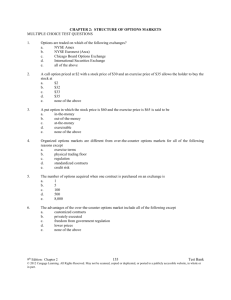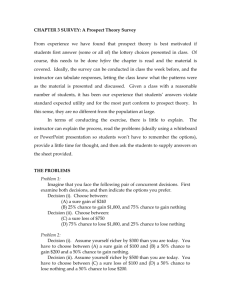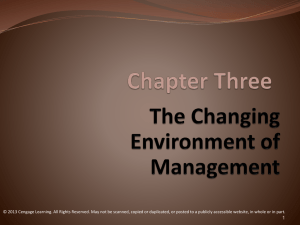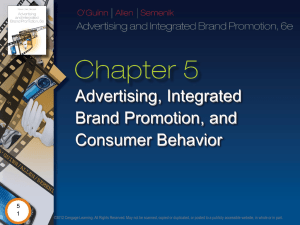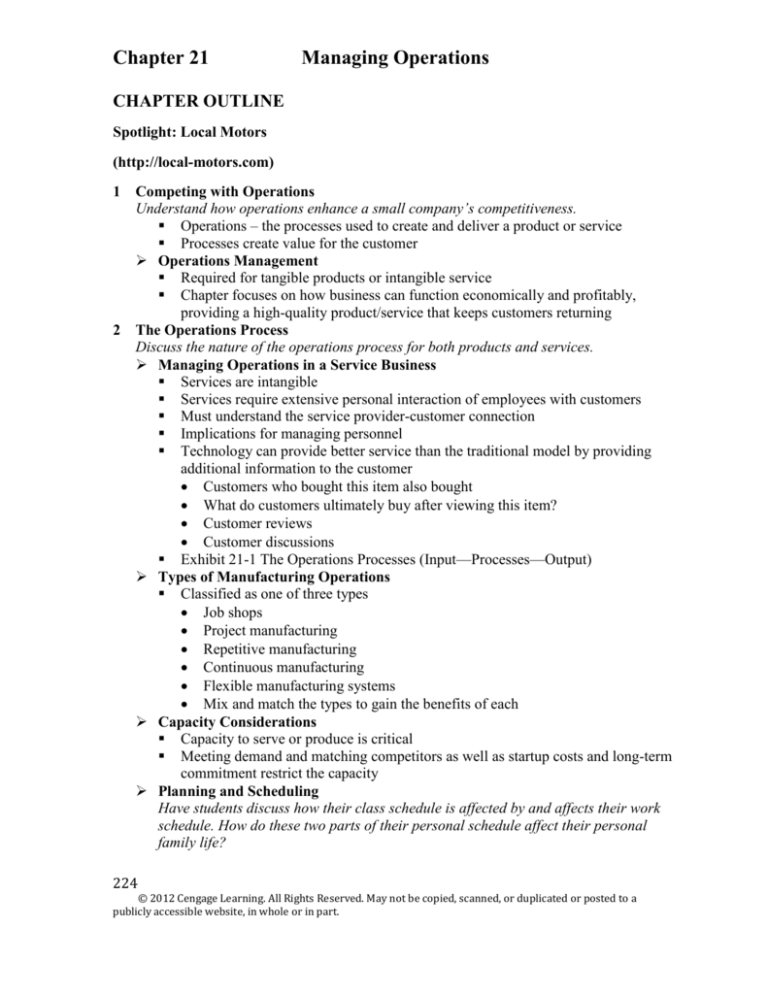
Chapter 21
Managing Operations
CHAPTER OUTLINE
Spotlight: Local Motors
(http://local-motors.com)
1 Competing with Operations
Understand how operations enhance a small company’s competitiveness.
Operations – the processes used to create and deliver a product or service
Processes create value for the customer
Operations Management
Required for tangible products or intangible service
Chapter focuses on how business can function economically and profitably,
providing a high-quality product/service that keeps customers returning
2 The Operations Process
Discuss the nature of the operations process for both products and services.
Managing Operations in a Service Business
Services are intangible
Services require extensive personal interaction of employees with customers
Must understand the service provider-customer connection
Implications for managing personnel
Technology can provide better service than the traditional model by providing
additional information to the customer
Customers who bought this item also bought
What do customers ultimately buy after viewing this item?
Customer reviews
Customer discussions
Exhibit 21-1 The Operations Processes (Input—Processes—Output)
Types of Manufacturing Operations
Classified as one of three types
Job shops
Project manufacturing
Repetitive manufacturing
Continuous manufacturing
Flexible manufacturing systems
Mix and match the types to gain the benefits of each
Capacity Considerations
Capacity to serve or produce is critical
Meeting demand and matching competitors as well as startup costs and long-term
commitment restrict the capacity
Planning and Scheduling
Have students discuss how their class schedule is affected by and affects their work
schedule. How do these two parts of their personal schedule affect their personal
family life?
224
© 2012 Cengage Learning. All Rights Reserved. May not be copied, scanned, or duplicated or posted to a
publicly accessible website, in whole or in part.
Chapter 21
Managing Operations
Production planning and scheduling procedures designed to achieve the orderly,
sequential flow of products through a plant at a rate matching deliveries to
customers
Demand management strategies used to stimulate customer demand when it is
normally low
3 Inventory Management and Operations
Identify ways to control inventory and minimize inventory costs.
Objectives of Inventory Management
Know how much inventory is available at all times to meet customer needs and
wants
Know the high and low points required to meet needs and wants throughout the
year
Inventory Cost Control
Economic order quantity
Statistical inventory control
Consider
Storage
Theft, weathering, spoilage, and obsolescence
Cost of capital
Transaction costs
Insurance and security
Disposal costs
ABC Inventory Classification
Classifies items in inventory by relative value
A = high-value items
B = less costly items
C = low-cost or noncritical items
Just-In-Time Inventory Systems
Reduces inventory levels to an absolute minimum
Allows quality problems to become evident more quickly to reduce waste
Used by businesses of all sizes with good results
Inventory Record-Keeping Systems
Physical inventory system
Cycle counting
Perpetual inventory system
Two-bin inventory system
4 Operations Management and Quality
Recognize the contributions of operations management to product and service quality.
Quality as a Competitive Tool
Discuss how quality affects a business that sells products as well as a business that
sells services. Ask students about the service provided by a business that sells
products.
Features of a product/service that enable it to satisfy customers’ needs
Total quality management (TQM)
© 2012 Cengage Learning. All Rights Reserved. May not be copied, scanned, or duplicated or posted to a
publicly accessible website, in whole or in part.
225
Chapter 21
Managing Operations
Customer driven
Organizational commitment
Culture of continuous improvement
The Customer Focus of Quality Management
Retail is Detail
Customer Feedback
“The Basic Seven” Quality Tools
Cause-and-effect diagram (or Ishikawa chart or fishbone chart)
Check sheet
Control chart
Histogram
Pareto chart
Scatter diagram
Flow chart (or run chart)
Quality Inspection versus Poka-Yoke
Inspection – examination of a part or a product to determine whether it meets
quality standards
Poka-Yoke is a proactive approach to quality management that seeks to mistakeproof a firm’s operations, thus avoiding problems and waste before they can occur
Statistical Methods of Quality Control
Acceptance sampling
Attributes
Variables
International Certification for Quality Management
ISO 9000 certification
Environmental concerns and a focus on social responsibility create new
opportunities and challenges for entrepreneurs
Quality Management in Service Businesses
5 Purchasing Policies and Practices
Explain the importance of purchasing and the nature of key purchasing policies.
The Importance of Purchasing
Quality depends on raw materials used
High-quality merchandise makes retailer’s sales to customers easier and reduces
the number of necessary markdowns and merchandise returns
Make or Buy?
Making component parts list on page 563
Buying component parts list on page 563
Outsourcing
Coops and the Internet
Diversification of Supply
Reasons to concentrate purchases with one supplier
Franchises may require specific suppliers
Measuring Supplier Performance
Supply Chain Operations Reference (SCOR) model
226
© 2012 Cengage Learning. All Rights Reserved. May not be copied, scanned, or duplicated or posted to a
publicly accessible website, in whole or in part.
Chapter 21
Managing Operations
Five attributes stand out
Reliability
Responsiveness
Agility
Costs
Assets
Building Good Relationships with Suppliers
Small business practices that help
Pay bills promptly
Give sales reps a timely and courteous hearing
Minimize abrupt cancellation of orders
Avoid attempts to browbeat a supplier into special concessions or unusual
discounts
Cooperate with supplier by making suggestions for product improvements
and/or cost reductions whenever possible
Provide courteous, reasonable explanations when rejecting bids and make fair
adjustments in the case of disputes
Forming Strategic Alliances
Partnering with suppliers and others
Choice determines whether the arrangement succeeds or fails
Some potential alliance partners design their business especially to help small
firms
Forecasting Supply Needs
Associative forecasting considers a variety of driving variables when determining
expected sales
Some businesses may require higher accuracy and thus need a more complex
model for forecasting
Using Information Systems
Computers, software, and Internet links with suppliers and customers
MIS are improved continuously
6 Lean Production and Synchronous Management
Describe lean production and synchronous management and their importance to
operations management in small firms
Lean Production
Guiding philosophy and management approach emphasizing efficiency through
elimination of waste in a company’s operations
Companies of all sizes use the principles of lean production
Synchronous Management
Bottleneck
Constraint
Exhibit 21-4 Service Level and Balance Sheet Considerations
© 2012 Cengage Learning. All Rights Reserved. May not be copied, scanned, or duplicated or posted to a
publicly accessible website, in whole or in part.
227
Chapter 21
Managing Operations
ANSWERS TO END-OF-CHAPTER DISCUSSION QUESTIONS
1. How important is managing operations to the competitiveness of a small
business? Why?
The customer’s idea of quality is the one that counts. The seller’s idea that a quality
rating of 8 is satisfactory is irrelevant if the buyer expects a quality rating of 9.5.
Repeat business depends on the customer’s evaluation of the product and/or
service. Does the product or service meet or exceed the customer’s expectations?
Even though the producer (seller) recognizes that the customer is the ultimate
arbiter, that producer may not correctly understand the customer’s expectations.
Efforts should be made not only to recognize the importance of meeting customer
expectations but also to discover the nature of those expectations and the extent to
which they are being met.
2. What are some distinctive features of the operations process in service firms?
Total quality management (TQM) refers to a people-focused philosophy of
management that stresses the need to continue to increase customer satisfaction and
lower cost. Quality becomes a major goal of the business. It entails the management
changes needed to encourage and measure quality in both design and processes,
and in both raw materials and employee performance. The ultimate goal of TQM is
to have zero defects and to strive for ever more responsive customer service.
Several methods are used to produce quality, including quality circles, inspection,
and statistical quality control techniques.
3. Customer demand for services is generally not uniform during a day, week, or
other period of time. What strategies can be used by service businesses to better
match a company’s capacity to perform services to customers’ demand for those
services?
Some firms, such as beauty shops, use appointment systems. Others (for example,
dry cleaners) take customers’ orders and work the orders into their own production
schedules. Still other firms, such as theaters, maintain a fixed schedule of operation
and tolerate fluctuating demand. Restaurants use incentives such as “early bird
specials” to promote greater use of services during off-peak hours.
4. What are the major features of the just-in-time inventory system? Is it applicable
to small companies? Be prepared to defend your answer.
Traditional methods will not usually suffice in a small manufacturing plant. Studies
have been made of 100 percent reinspections conducted in many plants; in every
case, further defectives were found in lots that were reinspected. In one such case,
nine reinspections were required before the lot was found to be free of defectives.
228
© 2012 Cengage Learning. All Rights Reserved. May not be copied, scanned, or duplicated or posted to a
publicly accessible website, in whole or in part.
Chapter 21
Managing Operations
Moreover, an inspector may measure and identify good items and defectives
correctly but still deposit them in the wrong container (good items in the rework
barrel and vice versa). One cause of such inaccuracy is the monotony created by
repetition of movements, measurements, and evaluation, such as the inspection of
1,000 to 5,000 items per lot.
5. Why is the customer focus of quality management so important in a small firm?
Why can be done to ensure that the quality of a small venture’s products or
services remains high?
The operations process in service firms must deal with distinctive features such as
measuring an intangible service e.g. the quality of a shampoo. In general, it is
harder to measure quality of a service than the quality of a physical object. Also
the process is often complicated by the interaction between the customer and the
process. A dentist, for example, works on the customer. Scheduling is often more
complicated because of the need to relate to the customer’s schedule.
6. How important is effective purchasing to a small business? Can the ownermanager of a small firm safely delegate purchasing authority to a subordinate?
Explain.
Some firms, such as beauty shops, use appointment systems. Others (for example,
dry cleaners) take customers’ orders and work the orders into their own production
schedules. Still other firms, such as theaters, maintain a fixed schedule of operation
and tolerate fluctuating demand. Restaurants use incentives such as “early bird
specials” to promote greater use of services during off-peak hours.
7. Under what conditions should a small manufacturer either make component
parts or buy them from others?
A small firm should make component parts if doing so (1) uses excess plant
capacity, (2) increases supply reliability, (3) protects proprietary technology, (4)
reduces costs, (5) facilitates production coordination, and/or (6) yields higher
quality components that are otherwise available. The firm should buy these
components if (1) outside suppliers can provide cheaper inputs, (2) doing so will
not require additional resources, (3) this prevents the diffusion of managerial
expertise, (4) it provides increased flexibility, (5) this strategy transfers the risk of
obsolescence to an outside party, and/or (6) it shifts obsolescence risk to outsiders.
8. What are the relative merits of inspection approaches and poka-yoke to quality
assurance in a small company?
Reengineering is an attempt to increase productivity by going beyond minor,
incremental changes in production systems to make more basic or fundamental
structural changes. It asks questions about the nature of the business and ways in
© 2012 Cengage Learning. All Rights Reserved. May not be copied, scanned, or duplicated or posted to a
publicly accessible website, in whole or in part.
229
Chapter 21
Managing Operations
which its operations might be improved. Reengineering, if carried out correctly,
avoids the error of making tiny improvements in inherently defective systems. An
underlying assumption is that an operations system designed twenty years ago may
no longer be the best operations system.
9. What steps can a company take to build good relationships with suppliers? Can
you think of any ethical issues that should be taken into account when deciding
how to interact with suppliers?
Productivity is concerned not only with the volume of output but also with the
quality of the products. Productivity is improved, therefore, as output is increased
and also as quality is improved. Quality improvement prevents the reworking of
defective items and minimizes customer dissatisfaction and costs associated with
warranties.
10.
Explain the meaning of the terms lean production and synchronous
management. How are these relevant to operations in a small company?
Purchasing would be a vital function if, for example, the firm faces a relatively high
cost of goods sold (i.e., if this expense has a significant effect on gross margins).
Other concerns, such as the potential impact on input quality, should also be
considered. Whether the owner-manager can safely delegate purchasing authority
to a subordinate depends on the capability and training of the subordinate and the
importance of inputs to be purchased.
COMMENTS ON CHAPTER “YOU MAKE THE CALL” SITUATIONS
Situation 1
1. Is the writer of the article correct in believing that quality levels not are generally
higher and that quality differences among businesses are minimal?
As a sweeping generalization, this may well be true. In the last two or three
decades, attention to quality has increased dramatically, and this has truly yielded
significant results. However, the owner needs to realize that there may be vast
differences from industry to industry. Also, the quality of pizza available in local
markets varies widely as local pizza enthusiasts can testify. Therefore, the writer
is probably right, in general, but might be wrong in this situation.
2. What are the benefits and drawbacks of placing the firm's primary emphasis on
minimizing customer waiting time?
Benefits would include:
230
© 2012 Cengage Learning. All Rights Reserved. May not be copied, scanned, or duplicated or posted to a
publicly accessible website, in whole or in part.
Chapter 21
Managing Operations
(a) Directing attention to an issue of real importance to most customers
(b) Possibly gaining an advantage over competitors on this feature
(c) Finding weaknesses in present delivery systems
Drawbacks would include:
(a) Overlooking quality problems that may exist
(b) Possibly creating quality problems by focusing on speed
(c) Giving insufficient thought to still other aspects of operations that may need
improvement (that is, by trying to solve the wrong problem)
(d)
3. If you were advising the owner, what would you recommend?
This question allows for individual answers that should be supported by sound
reasoning. Ideally, there should be clear recognition of the great importance of
quality, the present level of quality, how the owner can discern this level (e.g.,
through comparisons with competitors), and how this level might be measured.
Getting a bad pizza fast is not a good outcome! Also, it is desirable to give some
thought to the competition that typically exists between quality and speed and
consider ways to minimize that conflict. We should note that speed is measured
more easily than is quality.
Situation 2
1. What are the ethical issues raised by Tandy’s payment practices?
The ethical implications here are a bit nebulous. Clearly he is violating the terms
of the purchase agreement, however, the onus is on the supplier to enforce the
payment terms. Tandy has a moral obligation to adhere to the 30 day payment
terms however, paying 10-15 days beyond this is not an egregious act. To default
on the amount owed would be an egregious act.
2. What impact, if any, might these practices have on the firm’s supplier
relationships? How serious would this impact be?
Building good relationships with suppliers is essential for the success of an small
business. Tandy could jeopardize his working relationship with these suppliers and
they could decide to stop selling to him if he doesn’t pay his bills on time. Tandy
needs to implement a policy of fair play and cultivate a good relationship with his
suppliers. He can do this by:
Paying bills promptly
Giving sales representatives a timely and courteous hearing.
Minimizing abrupt cancelation of orders
© 2012 Cengage Learning. All Rights Reserved. May not be copied, scanned, or duplicated or posted to a
publicly accessible website, in whole or in part.
231
Chapter 21
Managing Operations
Avoiding attempts to browbeat a supplier into special concessions or
unusual discounts
Cooperating with the supplier by making suggestions for product
improvements
Providing courteous and reasonable explanations when rejecting bids.
3. What changes in company culture, employee behavior, or relationships with
other business partners may result from Tandy’s practices?
Others may lose respect for him and / or not want to do business with him. If Tandy
proves to make promises that he can’t keep, he will lose credibility with this
employees, suppliers and customers. Suppliers may talk to other suppliers and
Tandy may be in a position where he can’t get competitive bids on products, thereby
increasing his cost structure and lowering his profits. An extreme and consistent
trend of this behavior could result in Tandy’s going out of business.
Situation 3
1. What can be done to improve capacity?
An examination should take place to look for constraints or bottlenecks during peak
times. If these are found to exist and then changed, this would solve the problem.
2. What can be done to improve efficiency?
The bottlenecks and/or constraints that might be discovered could also have an
impact on efficiency. Changing these could lead to more efficient operations at the
different stations. Training could have an impact on efficiency as well.
3. What can be done to improve the filtering process?
One possibility to handle the filtering process is to have an employee check with
the customers who are standing in line to take order before they reach the counter.
This might forewarn of shortages before the customer reaches the station and allow
employees to obtain items/materials by the time the customers get to the station.
4. What could be done at a store level to improve the performance of the business?
232
© 2012 Cengage Learning. All Rights Reserved. May not be copied, scanned, or duplicated or posted to a
publicly accessible website, in whole or in part.
Chapter 21
Managing Operations
There are several options. Among them is to hire part time employees for peak
periods and develop training programs to allow all employees to be better
prepared for the needs of customers. A measure for bottlenecks and constraints
must be established to allow the business to meet the needs of customers at a
rapid pace. Establishing the cashier station away from the barista station and/or
the drive-through station could allow customers to establish separate lines that
don’t interfere with each other. Providing designated locations for the different
lines could also create help with improving the performance.
SUGGESTED SOLUTION TO CASE 21: RIVER POOLS & SPAS
1. Review the history of the operations of River Pools & Spas, from start to
success, to scaling back. How was the company affected by scaling back? What
changes made it more competitive?
2005 River Pools & Spas have over 75 in-ground pool installations, 20 fulltime employees, and a new 10,000 square foot showroom/warehouse
2006 they installed 80 in-ground pools in a declining economy
2007 they installed 88 in-ground pools in a declining economy
2010 the economy crashed. Sales were down and they had too many
employees. They are now down to six employees (a bookkeeper, office
manager, two production managers and two installation crews).
To adjust for this downturn the company had to close up their brick-and mortar
showroom and moved everything to the Web. They are now the world-leader
website for fiberglass pools and get requests from Utah to Costa Rica where
before they only services the Maryland/Virginia region. Moving to the Web
broadened their customer base and has allowed them to tap customer markets that
before they never would have considered. Additionally, by dramatically reducing
their fixed overhead costs, they have increased their competitiveness in the
market.
2. Describe how River Pools & Spas’ customer focus affects the business. What
can the owners do to ensure that the quality of their products and services
remains high?
River Pools and Spas embodies the essential features of successful quality
management. The company is customer driven, with a commitment to the
organization and a culture of continue improvement. The three pillars of quality
success. The customer’s needs and wants are the core drivers for this business.
Management leads but the entire organization participates. The company is also
much more than a one-off effort. It focuses on a culture of continues
improvement.
© 2012 Cengage Learning. All Rights Reserved. May not be copied, scanned, or duplicated or posted to a
publicly accessible website, in whole or in part.
233
Chapter 21
Managing Operations
To ensure that the quality of their products and services remains high the
company can actively gain customer feedback. Having direct contact with
customers can serve as the eyes and ears of the business in evaluating existing
quality levels and customer needs. The company should also work hard to involve
and empower the customer in efforts to improve quality. To accomplish this they
can utilize surveys, interviews, or observation techniques. The company can also
utilize control charts to manage the quality of their products (eg. Scatter diagrams,
Pareto charts, flow charts, etc.)
3. Does this company use a synchronous management approach?
Synchronous management is an approach that recognizes the interdependence of
assets and activities and manages them to optimize the entire firm’s performance.
The approach presumes that the goal of the organization, and the definition of
performance that flows from it, is known and influences all decision making. It
requires an understanding of how a shift in one area of operations can affect the
rest of the organization- that is- it provides insight regarding interrelationships
between assets, changes in activities, and achievement of the firm’s goals.
One can infer from the quick responsiveness, high quality and strong market share
that this company is functioning in a synchronous, harmonious way.
234
© 2012 Cengage Learning. All Rights Reserved. May not be copied, scanned, or duplicated or posted to a
publicly accessible website, in whole or in part.






